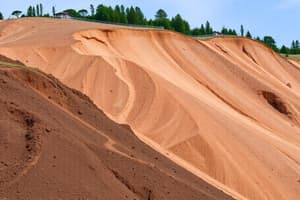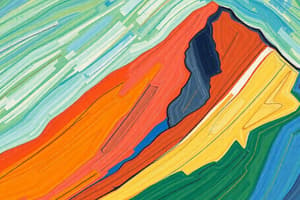Podcast
Questions and Answers
What is mass movement?
What is mass movement?
Mass movement is the movement of earth materials called regolith down a slope under the influence of gravity.
Explain what soil creep is.
Explain what soil creep is.
Soil creep is the very slow movement of soil, about 1 cm per year.
What causes soil to move downhill?
What causes soil to move downhill?
Water and gravity cause the soil to move slowly downhill.
Where can you find evidence of soil creep?
Where can you find evidence of soil creep?
What are bogbursts?
What are bogbursts?
Explain how a bog burst occurs.
Explain how a bog burst occurs.
What are the effects of bogbursts?
What are the effects of bogbursts?
What are mudflows?
What are mudflows?
What is a laher?
What is a laher?
What is a landslide?
What is a landslide?
What causes a landslide?
What causes a landslide?
What are the effects of landslides?
What are the effects of landslides?
Mass movement is more likely to occur when the slope is steep.
Mass movement is more likely to occur when the slope is steep.
Name one type of mass movement.
Name one type of mass movement.
How does lack of vegetation cause mass movement?
How does lack of vegetation cause mass movement?
Does water or frost help to lubricate the regolith, making mass movement more or less likely?
Does water or frost help to lubricate the regolith, making mass movement more or less likely?
Flashcards are hidden until you start studying
Study Notes
Mass Movement Overview
- Mass movement involves the downward movement of earth materials, specifically regolith, driven by gravity.
Soil Creep
- Characterized as the slowest form of mass movement, occurring at about 1 cm per year.
- Water and gravity contribute to this gradual soil movement, which alters landscape features.
Evidence of Soil Creep
- Observable signs include tilted fences and trees bending downhill.
- Formation of terracettes, natural steps on slopes.
- Accumulation of pressure can lead to collapsing walls; soil creep is faster at the surface than at greater depths.
Bogbursts
- Defined as rapid downhill movements of bog material.
- Triggered by heavy rainfall or land disturbance, such as vegetation removal for wind turbines.
Effects of Bogbursts
- Can create destructive flows of turf or peat, impacting houses, roads, and land.
Mudflows
- Described as swift flows of mud, often precipitated by heavy rainfall or volcanic activity.
- Can be caused by melted snow during volcanic eruptions, known as laher.
Landslides
- Represent rapid movements of loose rock and soil down a slope, often facilitated by factors like undercutting and coastal erosion.
- Heavy rainfall can loosen soil, increasing the likelihood of landslides.
Impacts of Landslides
- Can lead to significant damage by burying structures (houses, churches, schools).
- Pose risks to human life and can obstruct roads, complicating rescue efforts.
Slope Steepness and Mass Movement
- The likelihood of mass movement increases on steeper slopes compared to gentler slopes.
Vegetation's Role in Mass Movement
- Absence of vegetation allows soil to lose stability, leading to increased likelihood of downhill movement.
Influence of Water and Frost
- Water acts as a lubricant, enhancing the potential for mass movement by making regolith more mobile.
Studying That Suits You
Use AI to generate personalized quizzes and flashcards to suit your learning preferences.




